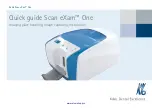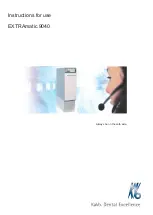
Hard Ground
If the ground is too firm to obtain the desired aeration
depth, the coring head can get into a bouncing
rhythm. This is due to the hard pan that the tines are
attempting to penetrate. Correct this condition by
using one or more of the following recommendations:
•
You obtain the best results after a rain or after
watering the turf the previous day.
•
Reduce the number of tines per stomper
arm. Attempt to maintain a symmetrical tine
configuration to evenly load the stomper arms.
•
Reduce aerator penetration (depth setting) if
ground is hard packed. Clean up cores, water turf,
and aerate again at a deeper penetration.
Aerating soil built on top of hard subsoils (i.e.,
sand/soil cap placed over rocky ground) can cause
undesired hole quality. This occurs when the aeration
depth is greater than what the tines can penetrate
through the soil cap and the subsoil. When the tines
contact hard subsoil, the aerator may lift and cause
the top of the holes to become elongated. Reduce the
aeration depth sufficiently to avoid penetration into
the hard subsoil.
Longer/Larger Tines
25 cm (10 inches) or More
Using longer/larger tines can leave the front or rear of
the hole tufted or slightly deformed.
•
Hole quality for this configuration improves if you
reduce the coring head speed 10 to 15% from
full operating speed. For PTO powered aerators,
reduce the engine speed until the PTO speed is
400 to 420 rpm.
Note:
Reducing the engine speed does not affect
the forward spacing.
•
The position of the camber bracket can affect
pushed holes; refer to
(Models SR54, SR54-S, SR70 and SR70-S) (page
26)
or
Adjusting the Tine Angle (Model SR72)
(page 27)
.
Multi Row Adapter Heads
When using multi-row adapter heads, reduce the
engine speed until the PTO speed is 400 to 420 rpm.
Note:
Reducing the engine speed does not affect
the forward spacing.
Root Zone Lifting
Using multi-tine heads in conjunction with larger
coring tines or large diameter solid tines can induce
significant stress on the root zone of the turf. This
stress can fracture the root zone and cause a lifting
action to the turf. If lifting damage occurs, try one or
more of the following:
•
Reduce tine density—remove some of the tines
•
Decrease coring depth—in 13 mm (1/2 inch)
increments (suggested)
•
Increase forward hole spacing—change
transmission of the traction unit up one gear
•
Decrease the tine diameter—solid or coring
Adjusting the Tine Angle
(Models SR54, SR54-S,
SR70 and SR70-S)
Set the tine angle according to the tine length by
using one of the 2 adjustment holes in the linkage
arm. These holes are presets only. When using 17.8
mm (7 inch) to 25.4 mm (10 inch) tines, position the
head bumper closest to the rear of the tine head. You
may need to use the other position—the hole farthest
from the head (
) due to variances of soil
conditions.
1.
Disengage the PTO and engage the parking
brake.
2.
Shut off the engine and remove the key from
ignition switch.
3.
Release the spring tension to the tine head
(
).
g266002
Figure 37
1.
Spring
3.
Adjustment hole
2.
Bumper bolt
4.
Spring pin and clip
4.
Remove the bumper bolt and bumper from the
linkage arm and reinsert them into the other
adjustment hole (
).
5.
Connect the spring tension to the tine head.
26















































